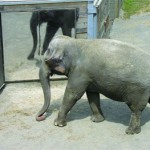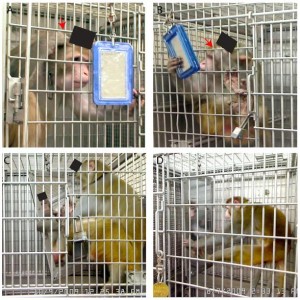“Mirror, mirror on the wall, who is the smartest animal of them all?”
Self-awareness is an ability that was previously thought to be unique only to humans. For example, how many times have you stationed yourself in front of a full length mirror (alone) and checked yourself out? If you are a guy, maybe you are flexing your muscles; or if you are a girl, perhaps you are examining your blemishes. I know we are all hopelessly guilty of this! After all, we are experts on self-awareness.
 However, it has been discovered that humans are not alone in their ability to self-recognize.
However, it has been discovered that humans are not alone in their ability to self-recognize.
Animals such as select chimpanzees, dolphins, magpies, and elephants have all
been observed to comprehend their existence as individuals separate from
thought, other individuals and the environment. In addition, a recent study
conducted on the Rhesus Monkeys (Macaca mulatta) has successfully added another mammal onto the growing list of self-observers.
With the use of a surgical implant, several mirrors, and a mark test, a team of researchers from the University of Wisconsin tested these monkeys for the ability to self-recognize and thus be self-aware. The first experiment began by implanting an electrophysiological device into the monkeys’ skull to aid in physiological recordings of their brains. A mirror would then be placed inside their cages and the observations would begin. Researchers observed the monkeys grasp their new mirrors with one hand and tilt it at specific angles to groom the area around the implant. Similarly, researchers noted that the monkeys always turned to face their mirror and use it to guide their grooming process. Equally important, the monkeys did not try to groom the image in the mirror; they accepted the image to be their own reflection. Meanwhile, monkeys that had not been implanted were seen to not use the mirror. This suggests that the implant acted as a stimulus which prompted them to examine the location of the implant in the mirror. Therefore, this experiment was a success because the monkeys used the mirror as a tool to look at their reflection.
Self-recognition caught on camera! Rhesus Monkeys examining themselves in the mirror.
(The red arrow in A and B show which hand is used for grooming and the implants are masked with the black square for discretion in A, B, and C.)
Furthermore, another experiment the researchers conducted was a test of self-recognition through different mirrors. A small, a large, and an all black mirror (covered in a non-reflective plastic) were placed outside the Rhesus monkeys’ cage. The monkeys were found to use both the large and small mirrors but not the black mirror. Also, with the use of these mirrors, they were seen to inspect body parts that normally would be out of direct sight. As a result, the monkeys’ rate of touching and grooming was determined to be 10 times greater with mirrors than without. Therefore, this experiment was a success because the monkeys demonstrate self-directed actions.
Despite both of the above experiments showing the capability of Rhesus Monkeys self-recognition, one test failed in its objective. This failed test consisted of applying marks on the animal’s faces and observing their behaviour in front of a mirror. The hypothesis was that the Rhesus Monkey would look into the mirror, acknowledge the presence of the marks and touch them. This would conclude that the animal recognized itself in the mirror and therefore was self-aware. Unfortunately, this test failed because there was no attempt by the monkeys to touch the markers. This result could suggest either that they had observed the markers but made no attempt to touch them, or that they had not recognized them at all.
In conclusion, with two successful experiments and one failed experiment, the University of Wisconsin research team determined that overall the Rhesus Monkeys can recognize themselves in the mirror and therefore can be considered self aware.
Although in the past humans selfishly considered themselves the only species capable of self-recognition; science has one again proved us wrong. Thanks to advances in scientific research, we now have another common characteristic linking us to different species. The Rhesus Monkey is only one of a handful of animals that can acknowledge their own reflections as being unique. Before too long, maybe we will even discover these creatures checking out their appearances in the mirror in hopes to fix their hair or flex their muscles.
Further Reading:
Research Article: Rhesus Monkeys (Macaca mulatta) Do Recognize Themselves in the Mirror: Implications for the Evolution of Self-Recognition
Science News: Rhesus Monkeys Appear to Have a Form of Self-Awareness Not Previously Attributed to Them, Research Suggests

September 28th, 2011 at 3:33 pm
I always appreciate reading about research that reports results that do not support the researcher’s hypothesis. I wonder why the monkeys didn’t touch the marks on their face! I guess I should read the full paper!
October 1st, 2011 at 9:35 am
In the past, I always assumed that all animals had the ability of self-awareness until I saw this YouTube video titled “puppy vs. mirror.” It really made me question what other animals were unable to recognize themselves when they see their reflection. The experimental method of this study from the University of Wisconsin was quite interesting and thorough. The images really put what was happening into perspective. Your post makes me want to research what other animals have self-recognition as well!
October 7th, 2011 at 9:31 pm
Did the scientists test this on other animals as well? If they haven’t which animals do you think might be self-aware and be able to mark their face?
October 9th, 2011 at 12:21 pm
I do not believe these particular scientists tested the implant method on any other species. However, I did read that the mark test was successful in chimpanzees and elephants.
October 23rd, 2011 at 2:26 pm
I also read about a test on magpies. Their ability of self-recognition was also based on mark tests (if they see the mark in the mirror and try to touch the mark on themselves).
[Mirror-Induced Behavior in the Magpie (Pica pica): Evidence of Self-Recognition
http://www.plosbiology.org/article/info%3Adoi%2F10.1371%2Fjournal.pbio.0060202%5D
It was exciting to read about the different ways of judging self-recognition!